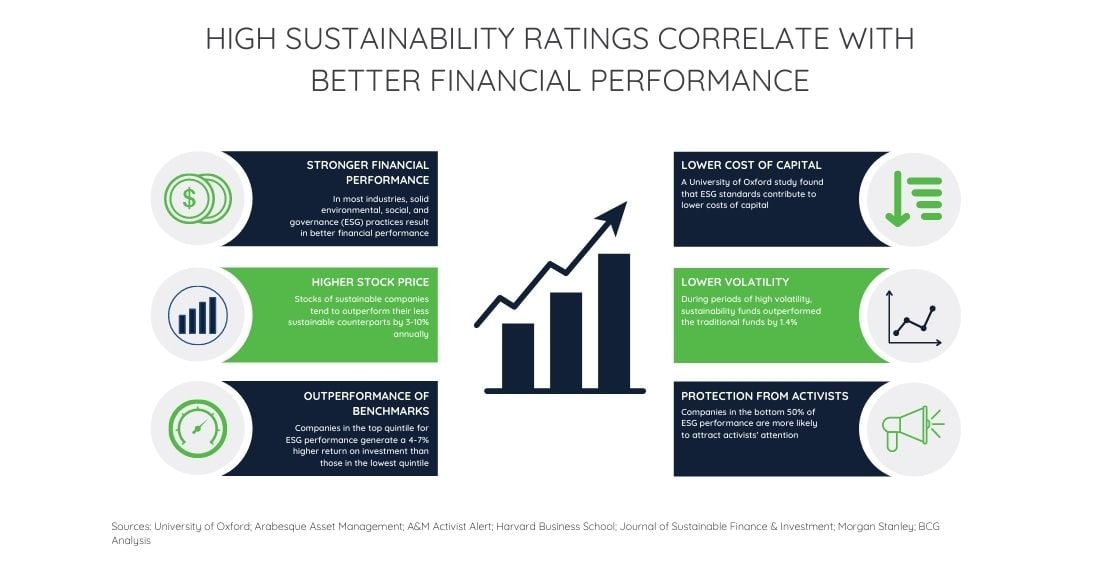Sustainability Initiatives For Aerospace And Defense: Is It Important?
Sustainability initiatives have become front and center in the minds of a growing number of companies spanning nearly all sectors. This trend stems from demands by both stakeholders and clients for more accountability, transparency, and precise commitments to build a better future for people and the planet.
In addition to governments continuously tightening due diligence requirements:
- Customers are more aware of the impacts of their purchasing habits,
- Environmental activists alert us of the loss of biodiversity and the threats of climate change,
- NGOs are denouncing corruption and modern-day slavery,
- Investors are no longer making decisions based on P&L statements but now also consider ESG ratings
Some industries have historically not been associated with sustainability initiatives, like Aerospace and Defense (A&D). But this won’t be the case for much longer.
Investors have traditionally applied negative screening to exclude A&D from their portfolios. The high level of technology of these sectors, however, displays an interesting potential for profit, having performed rather well over the past ten years compared to the S&P 500 index– be it in services to the civil market or to the military – a fact that puts A&D companies on the map for investment and government funding, provided they report on sustainability initiatives via ESG reporting or CSR programs.
Material Sustainability Factors For A&D Manufacturers
The nature of the A&D industry requires stringent regulations from governments and provokes intense scrutiny from stakeholders. Manufacturers and procurement professionals are already focused on finding the balance between reducing costs and delivering on quality and safety expectations. Now they must also focus on areas where they can and should intervene to strengthen their competitive standing and their brand.
Some factors will be challenging, some present more immediately attainable goals. Boeing, for example, has managed to integrate over a dozen sustainability principles into its operations and is able to reach far and wide given its global coverage.
CSR And ESG Initiatives To Consider
Human Capital: Inclusion, Diversity, Labor Protection
Not all societies value equality, and opportunities for more diversity and inclusion have historically not been in favor of women in engineering or in leadership positions.
On the other end of the supply chain spectrum, employee protection laws may be less than standard at best. Some countries disregard fair wages, safety, and health programs. Opaque supply chains are notorious for hiding modern day slavery practices, including forced labor and child labor, for many of the raw materials used in the A&D industries.
Bribery And Corruption: Preserving Corporate Liability
National authorities are tightening the grip on bribery and corruption practices in the Aerospace and Defense sector especially. According to a JD Supra publication:
“ […] companies will need to be increasingly responsive to national law enforcement authorities, and ensure that they pay careful attention to corporate liability and debarment risks.”
Product Sourcing: Ethical Supply Chains
Technology like satellite communication and missile guidance systems are either hard to source sustainably and/or linked to forced labor and damaging extraction methods. Rare earth metals and cobalt are some of the unregulated materials that have yet to be subject to compliance requirements but whose supply chains often contain unethical practices.
The Challenge Of GHG Emissions
Reducing GHG emissions is by far the greatest challenge of the industry because of its nature and the lack of suitable alternatives to fossil fuel consumption.
Commercial aviation is a heavy producer of global greenhouse gas emissions (2% in 2019, a not so relevant number since fleets were grounded on account of travel bans). BCG suggests that it could rise to 20% by 2050 without major intervention.
Governments are also on a quest to tackle the problem and demand companies work toward reaching Net Zero. The Biden Administration announced a 50% reduction by 2030, which doesn’t leave much time for companies to measure Scopes 1, 2, and 3 emissions and take action.
Other existing national or regional regulations in the form of carbon taxes and cap-and-trade only lead to increased operational costs.
Why Are Sustainability Programs Important For A&D?
Social impact, climate change, inequality are a few of the challenges A&D organizations face but must take on sooner rather than later. Here are some of the reasons why.
Regulatory Bodies’ Involvement
Is the SEC planning ESG disclosing rules for publicly traded companies? Yes.
SEC acting chair Allison Herren Lee says:
“Human capital, human rights, climate change – these issues are fundamental to our markets, and investors want to and can help drive sustainable solutions on these issues. We see that unmistakably in shifts in capital toward ESG investing, we see it in investor demands for disclosure on these issues […]”
Due to a lack of performance towards the Paris Agreement goals, there will likely be legislation in the near future for Greenhouse Gas in both the EU and the US.
Pressure From The Public
Customers, especially from the public sector, are demanding products and services that are compliant with ethical practices.
Shareholders and investors request actions on climate change to grant access to capital.
Communities (and the press) hold organizations to higher standards and resort to inflicting reputational damage if companies fail.
Employees seek access to work satisfaction in return for which they will be more productive.
What Are The Ultimate Benefits For Your A&D Organization?
Simply put, sustainability in your organization AND throughout your supply chain equals:
- Better financial performance
- Higher stock price
- Lower capital cost
- Maintained equity value
- Lower volatility
- Higher return on investment
- Protection from activists’ attention

Another non-negligible benefit is a competitive advantage. As A&D customers increasingly screen business practices (pertaining to climate change in particular), your position in the sustainability front will contribute to a steady flow of orders, provided you still deliver on safety, reliability, and performance.
How To Make It Through?
Change is not easy, especially in an industry known for its complexity and core mission to protect and defend. Keep in mind it’s a collective effort between you and your suppliers. Supply chains are growing more complex, more global, but the good news is the world is also more digitized.
It is impossible and counterproductive to want to address every issue, as tempting as might be. To get started on your ESG journey and help you prioritize your battles, Source Intelligence has put together an informative white paper you can download in a few clicks. You’ll learn:
- What is ESG and ESG Reporting?
- What’s Driving the Shift Towards ESG?
- The Different ESG Frameworks
- How You Can Start ESG Reporting
Don’t delay and lose the race to sustainability. Download our ESG Reporting guide by clicking the button below.



